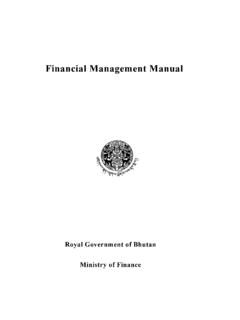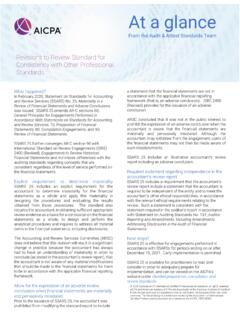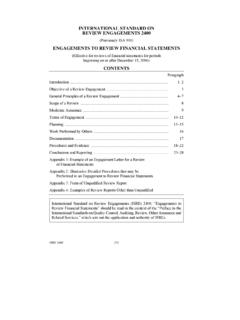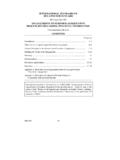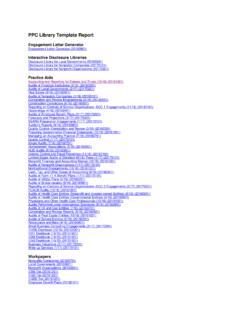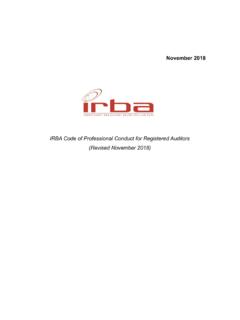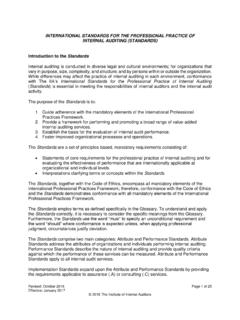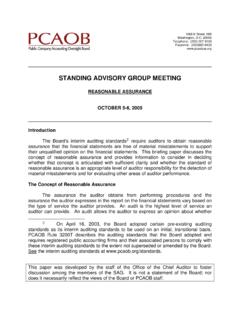Transcription of INTERNAL AUDIT MANUAL
1 INTERNAL AUDIT ManualiMinistry of FinanceiINTERNAL AUDIT MANUALM inistry of FinanceRoyal Government of Bhutan2014 INTERNAL AUDIT ManualiiMinistry of FinanceiiInternal AUDIT ManualiiiMinistry of Financeiii ROYAL GOVERNMNET OF BHUTANMINISTRY OF FINANCETASHICHHO DZONGI nternal AUDIT ManualivMinistry of FinanceivInternal AUDIT ManualvMinistry of FinancevTABLE OF CONTENTS PagesPREFACE CHAPTER I INTERNAL AUDIT SERVICES FRAMEWORK AND STRUCTURE 11. Background 12. Management Responsibilities and Accountability Framework 13. Organizational Structure of INTERNAL AUDIT Services 24.
2 The INTERNAL AUDIT Charter 25. Definition and Purpose of INTERNAL AUDIT 36. The Code of Ethics for INTERNAL Auditors 37. INTERNAL Auditing Standards 48. Professional Attributes of the INTERNAL AUDIT Unit and the INTERNAL Auditors 5 9. AUDIT Process Overview 9 CHAPTER II GOVERNANCE, RISK MANAGEMENT, INTERNAL CONTROL AND FRAUD 141. Introduction 142. Governance 153. Risk Management and Risk Assessment 194. INTERNAL Control 245. Fraud Management 276. Periodic Reporting to Chief Executive on Governance, Risk Management, INTERNAL Control and Fraud Issues. 35 CHAPTER III INTERNAL AUDIT STRATEGY AND ANNUAL AUDIT PLANNING 501.
3 Introduction 502. INTERNAL AUDIT Strategy 523. Planning Principles 534. Resources 555. Planning Process 576. Annual AUDIT Plans 63 CHAPTER IV PLANNING AND CONDUCTING INTERNAL AUDIT ENGAGEMENTS (FIELDWORK) 661. Introduction 682. Initiating the AUDIT Engagement 693. Planning the AUDIT Engagement 704. Conducting the AUDIT Engagement (Fieldwork) 78 INTERNAL AUDIT ManualviMinistry of FinanceviCHAPTER V REPORTING THE RESULTS OF THE AUDIT ENGAGEMENT 861. Introduction 872. Form of INTERNAL AUDIT Report in the IAS 873.
4 Reporting Process 904. Presentation Styles 925. AUDIT Closure 93 CHAPTER VI MONITORING & FOLLOW-UP PROCEDURES 951. Introduction 952. Classifying the Status of Implementation 963. Data Base of AUDIT Recommendations 974. Monitoring Process 975. Follow-up Process 97 CHAPTER VII AUDIT EVIDENCE AND WORKING PAPERS 991. Introduction 992. Evidence 1003. Documenting AUDIT Evidence Working Papers 106 CHAPTER VIII QUALITY ASSESSMENT AND IMPROVEMENT 1131. Introduction 1142. Quality Assurance and Improvement Programme (QAIP) - Nature and Objectives.
5 1143. Implementation of the Quality Assurance and Improvement Programme 1154. Reporting and Acting on Results of Quality Assurance and Improvement Programme 117 INTERNAL AUDIT ManualviiMinistry of FinanceviiPREFACE1. This INTERNAL AUDIT MANUAL is issued by the Ministry of Finance in accordance with the requirements of Section 23 (o) of the Public Finance Act, 2007. 2. The INTERNAL AUDIT MANUAL is intended to: (i) Provide members of the INTERNAL AUDIT Service in the Royal Government of Bhutan (RGoB) with practical professional guidance, tools and information for managing the INTERNAL AUDIT activity and for planning, conducting and reporting on INTERNAL AUDIT work.
6 The use of the MANUAL should help bring a systematic and disciplined approach to the AUDIT of governance, risk management and control processes and assist the INTERNAL Auditor meet the goal of adding value to their respective organizations (ii) Enhance the quality and effectiveness of the INTERNAL AUDIT Service by paving the way to put into practice procedures and processes that would help it conform to professional standards and best practices. 3. The MANUAL describes the generic processes for establishing risk based annual AUDIT plans, planning and conducting AUDIT engagements and reporting the results of the AUDIT work.
7 The MANUAL also provides perspectives on Governance, Risk Management, INTERNAL Control and Fraud that underpin almost all AUDIT work. Similarly the MANUAL also provides guidance on methods for collecting and documenting relevant AUDIT evidence. Procedures and processes for maintaining a quality INTERNAL AUDIT service are also provided. 4. The INTERNAL AUDIT Charter, which establishes the INTERNAL AUDIT Services in the RGoB, prescribes that the INTERNAL AUDIT Service in the RGoB shall conform to the Definition of INTERNAL AUDIT , the Code of Conduct and the Auditing Standards, which forms part of the International Professional Practices Framework (IPPF) established by the Institute of INTERNAL Auditors (the world-wide professional organization for INTERNAL auditing).
8 The IPPF also includes Position Papers, Practice Advisories and Practice Guides issued by the IIA from time to time to better understand and conform to the IIA Throughout the MANUAL , the IIA Standards directly applicable or relevant to the subject or particular procedures under consideration have been provided. References are also made to Practice Advisories and Practice Guides, where appropriate. In many instances, INTERNAL Auditors are encouraged to excise professional judgment, particularly in determining levels of risk, adequacy of INTERNAL control processes and the choice of appropriate AUDIT methodology.
9 Auditors and users of the MANUAL will do well to review and familiarize themselves with the IPPF and refer to these when using this MANUAL and performing INTERNAL AUDIT work. 6. The MANUAL outlines the principal INTERNAL AUDIT processes and activities. It is intended to serve as an efficient resource to explain the main principles and identify the relevant standards underlying the conduct of INTERNAL AUDIT activities. 7. The MANUAL is designed to be flexible and unrestrictive. In particular it is not intended to constrict any initiative that INTERNAL Auditors can bring to their work based on prior work experience, knowledge and skills.
10 Neither is the MANUAL intended to constrain the INTERNAL Auditors from excising their professional judgment. INTERNAL AUDIT ManualviiiMinistry of Financeviii8. Users of the MANUAL are expected to have at least basic knowledge and understanding of management frameworks including governance, risk management and control processes and be capable of exercising professional judgment. In addition to the IPPF, INTERNAL Auditors should also have a comprehensive understanding of the policies, regulations, rules and directives established by the various central agencies of the RGoB and their own organization in order to be able to apply the guidance provided in the MANUAL fruitfully.
